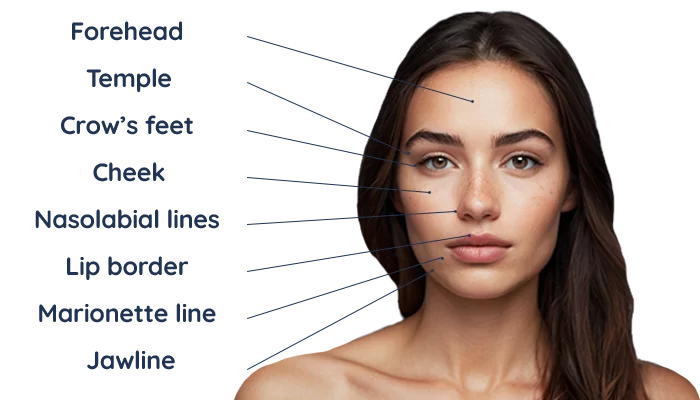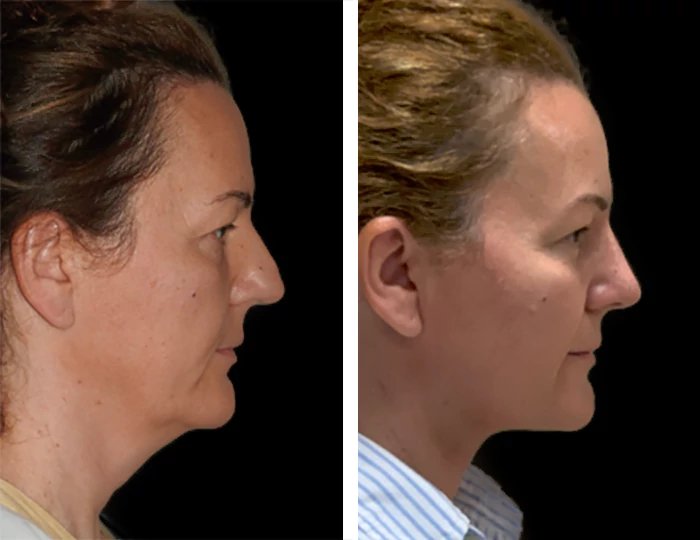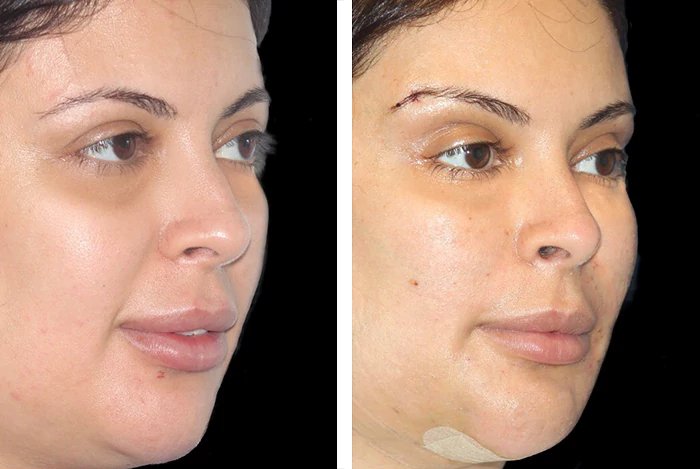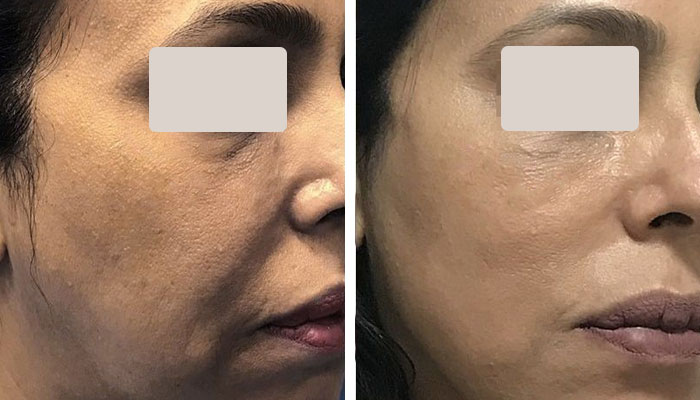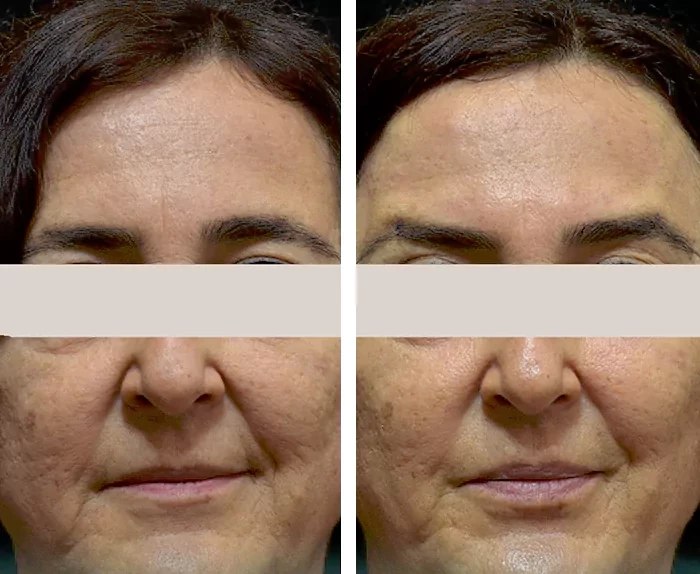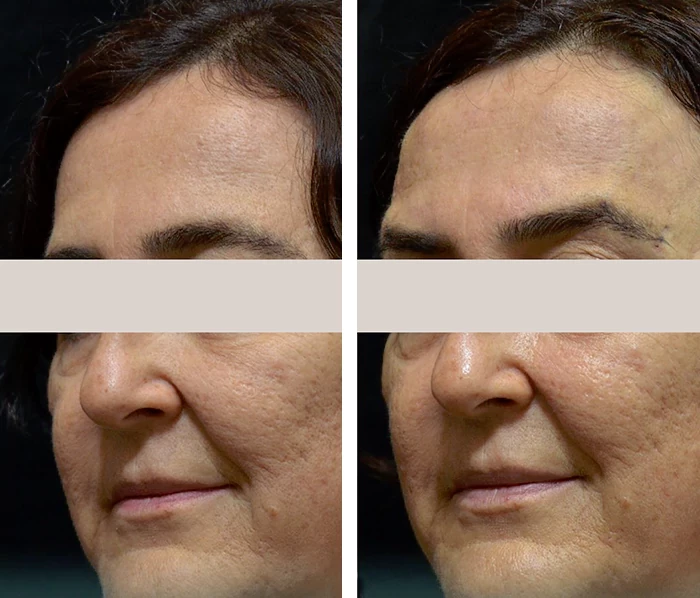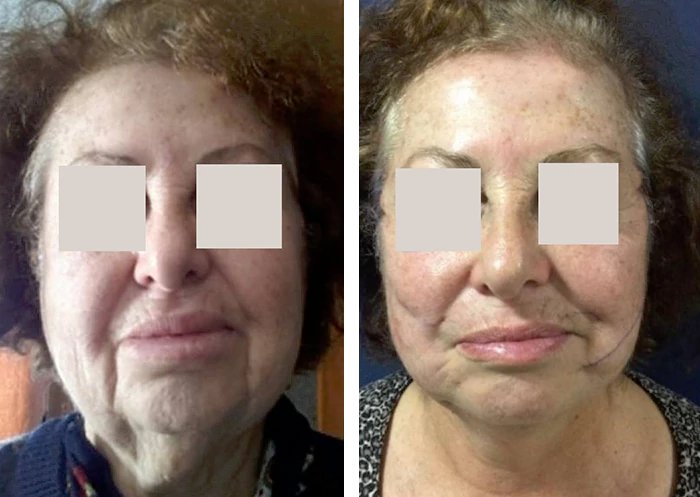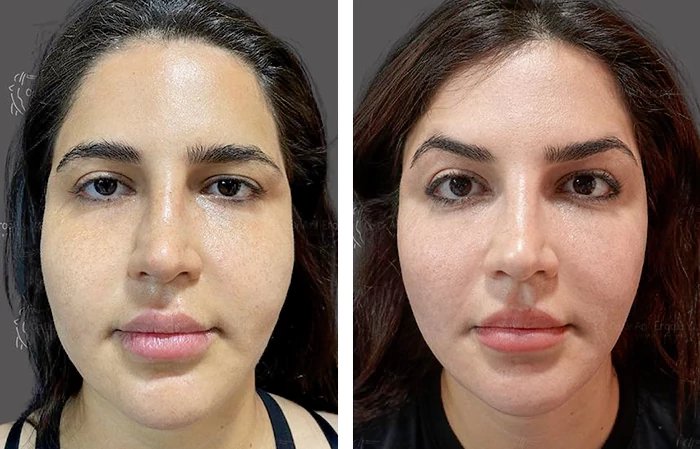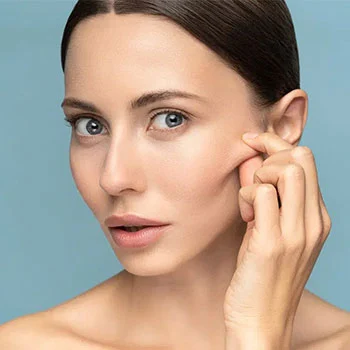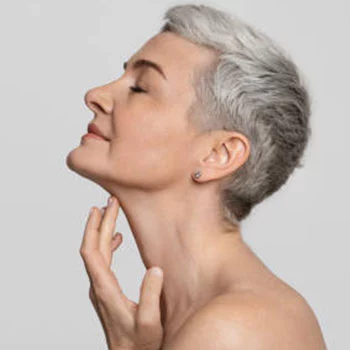What is a thread lift?
A thread lift is a non-surgical cosmetic procedure designed to lift and tighten sagging skin, typically on the face and neck. It involves the insertion of biodegradable threads into the skin, which are then used to lift and reposition the tissues for a more youthful and rejuvenated appearance. These threads are typically made of materials like polydioxanone (PDO) that gradually dissolve over time.
This procedure is considered minimally invasive, with a shorter recovery time compared to surgical alternatives, making it a popular choice for individuals seeking facial rejuvenation without extensive downtime.
How does a thread lift work?
During the procedure, a medical professional inserts the threads into specific areas of the face or neck using a thin needle or cannula. The threads have tiny barbs, cones, or sutures that anchor them to the underlying tissues, allowing for a lifting effect.
This mechanical lifting helps improve the contours of the face, reduce sagging, and enhance facial features. Additionally, the insertion of the threads stimulates the production of collagen, a protein that provides structural support to the skin. As the threads dissolve, the body's natural healing response is triggered, leading to increased collagen production and further tightening and rejuvenation of the skin over time. The results of a thread lift can be immediate, with further improvements seen as collagen production continues
What is a thread lift used for?
A thread lift is primarily used for facial rejuvenation and addressing specific concerns related to sagging or loose skin. Here are some common uses of thread lifts:
- Lift and tighten sagging skin: Thread lifts are effective in lifting and tightening sagging skin in various areas of the face, including the cheeks, jowls, jawline, and neck. The procedure can provide a more defined and youthful appearance by improving facial contours.
- Reduce wrinkles and fine lines: Thread lifts can help diminish the appearance of wrinkles and fine lines by lifting and tightening the skin. This can be particularly beneficial in areas such as the forehead, brows, and nasolabial folds.
- Improve facial volume and definition: Thread lifts can enhance facial volume and definition by repositioning sagging tissues and promoting collagen production. This can result in a more contoured and youthful appearance, especially in areas like the cheeks and chin.
- Non-surgical brow lift: Thread lifts can be used to lift and reposition the eyebrows, creating a more lifted and refreshed look without the need for surgery.
- Neck rejuvenation: Thread lifts can be effective in addressing sagging skin and improving the appearance of the neck. The threads can help lift the skin and redefine the jawline, reducing the appearance of jowls and neck laxity.
It's important to note that the specific uses and areas treated with a thread lift can vary depending on individual needs and goals. Consulting with a qualified medical professional is crucial to determine if a thread lift is suitable for your specific concerns and to discuss the potential benefits and limitations of the procedure.
Who is a thread lift for?
A thread lift is suitable for individuals who are experiencing mild to moderate signs of facial sagging or want to achieve facial rejuvenation without undergoing surgery. Here are some factors that may make someone a good candidate for a thread lift:
- Mild to moderate skin laxity: Thread lifts are most effective for individuals with mild to moderate sagging or laxity of the skin. It is not typically recommended for individuals with severe sagging, as they may require more extensive surgical procedures to achieve their desired results.
- Age-related concerns: Thread lifts are commonly sought by individuals who are experiencing age-related changes in their facial appearance, such as sagging cheeks, jowls, or a less defined jawline. It can also address concerns like wrinkles, fine lines, and loss of facial volume.
- Healthy individuals: Candidates for a thread lift should generally be in good overall health and have realistic expectations about the outcomes of the procedure. A thorough evaluation by a qualified medical professional is necessary to assess suitability and discuss potential risks and limitations.
- Non-surgical preference: Those who prefer a non-surgical alternative to facelift surgery or are not ready for a more invasive procedure may find thread lifts to be a suitable option. Thread lifts offer a shorter recovery time, minimal scarring, and fewer risks compared to surgical interventions.
- Collagen stimulation: Individuals who desire both immediate lifting effects and long-term collagen stimulation may benefit from a thread lift. The insertion of threads stimulates the production of collagen, leading to ongoing improvements in skin elasticity and firmness.
It's essential to consult with a qualified medical professional who can evaluate your specific concerns, assess your candidacy, and discuss the potential benefits and limitations of a thread lift procedure. They can provide personalized advice based on your individual needs and goals.
Types of thread lifts in terms of treatment area
Thread lifts can be categorized into various types based on the specific areas they target. Here are some common types of thread lifts based on treatment areas:
- Facial thread lift (thread facelift): This type of thread lift focuses on lifting and tightening the skin on the face. It can address concerns such as sagging cheeks, jowls, nasolabial folds (smile lines), marionette lines, and jawline definition.
- Brow thread lift: A brow thread lift specifically targets the eyebrows and forehead area. It can help lift drooping or sagging eyebrows, reduce forehead wrinkles, and create a more youthful and lifted appearance.
- Neck thread lift: Neck thread lifts are designed to improve the appearance of the neck area. They can help lift sagging skin, reduce the appearance of neck bands or wrinkles, and enhance the definition of the jawline.
- Eye thread lift: Also known as a non-surgical eyelid lift or a non-surgical blepharoplasty, an eye thread lift focuses on rejuvenating the eye area. It can lift droopy eyelids, reduce under-eye bags or puffiness, and improve the overall appearance of the eyes.
- Body thread lift: While thread lifts are more commonly associated with facial rejuvenation, there are also thread lift techniques that can be used for body contouring. Body thread lifts can target areas such as the arms, abdomen, thighs, or buttocks to improve skin laxity, firmness, and texture.
It's important to note that the availability of specific types of thread lifts may vary depending on the medical professional and the techniques they offer. Consulting with a qualified practitioner will allow you to determine the most suitable type of thread lift for your desired treatment area and individual concerns.
What to expect during the procedure
A thread lift is a minimally invasive cosmetic procedure that typically takes less time compared to traditional surgical interventions. The duration of a thread lift procedure can vary depending on several factors, including the areas being treated, the number of threads inserted, and the individual's response to the procedure. However, on average, a thread lift procedure can take anywhere from 30 minutes to an hour to complete.
Here is an overview of the steps you can generally expect in a thread lift procedure:
- Consultation: The process typically begins with an initial consultation with a qualified medical professional. During this consultation, you will discuss your concerns, goals, and medical history. The doctor will evaluate your facial anatomy, assess your suitability for a thread lift, and explain the procedure in detail.
- Preparation: Before the procedure, the treatment area will be thoroughly cleansed, and a local anesthetic may be applied or injected to numb the area. This helps ensure your comfort during the procedure.
- Thread insertion: Using a thin needle or cannula, the doctor will insert the threads into the targeted areas of the face or neck. The number and placement of the threads will depend on your specific concerns and goals. The threads used in thread lifts are typically made of biodegradable materials, such as polydioxanone (PDO).
- Lifting and positioning: Once inserted, the threads are gently pulled to lift and reposition the sagging skin or tissue. The doctor will carefully adjust the tension of the threads to achieve the desired lifting effect and improve facial contours.
- Completion: After the threads are positioned correctly, the excess thread is trimmed, and the procedure is completed. The tiny puncture sites where the threads were inserted are usually very small and do not require stitches.
- Recovery and post-procedure care: Following the procedure, you may experience some mild swelling, bruising, or discomfort in the treated areas. The doctor may provide specific instructions on post-procedure care, which may include avoiding strenuous activities, applying cold compresses, and taking any prescribed medications.
It's important to note that the exact details of the procedure may vary depending on the specific technique used by the doctor and your individual case. The duration of the procedure can also vary based on the number of threads and areas being treated. It is recommended to have a thorough discussion with your chosen medical professional to understand the procedure, potential side effects, and the recovery process specific to your situation.
Recovery and aftercare
After undergoing a thread lift procedure, it is important to take proper care of the treated areas during the recovery period. Following appropriate aftercare guidelines can help minimize discomfort, reduce the risk of complications, and promote optimal healing. Here are some general guidelines for recovery and aftercare:
- Rest and recovery: It is normal to experience some mild swelling, bruising, or discomfort in the treated areas following a thread lift. Take it easy for a few days and avoid strenuous activities, heavy lifting, or vigorous exercise to minimize the risk of complications and allow the treated areas to heal.
- Cold compresses: Applying cold compresses or ice packs to the treated areas can help reduce swelling and alleviate any discomfort. Be sure to wrap the ice pack in a thin cloth to protect your skin and avoid direct contact with ice.
- Avoid touching or rubbing: It is important to avoid touching or rubbing the treated areas immediately after the procedure to prevent any displacement of the threads. Follow the specific instructions provided by your medical professional regarding post-procedure care and avoid massaging the treated areas unless advised otherwise.
- Sleep position: Sleep with your head elevated for a few nights to minimize swelling and promote proper healing. This can be achieved by using an extra pillow or elevating the head of your bed.
- Medications: Your doctor may prescribe pain medications or recommend over-the-counter pain relievers to manage any discomfort or pain during the recovery period. Follow their instructions regarding medication usage.
- Skincare routine: Follow any specific skincare recommendations provided by your medical professional. Avoid harsh or abrasive skincare products, and be gentle when washing or applying skincare products to the treated areas.
- Follow-up appointments: Attend any scheduled follow-up appointments with your medical professional to monitor your progress, assess the results, and address any concerns or questions you may have.
It's important to note that these are general aftercare guidelines, and specific instructions may vary depending on your individual case and the techniques used in the procedure. Always consult with your medical professional for personalized aftercare instructions and follow them diligently to ensure optimal healing and the best possible results.
Side effects and complications
While thread lift procedures are generally considered safe, there are potential side effects and complications that can occur. It is important to be aware of these possibilities and discuss them with your medical professional before undergoing the procedure. Here are some commonly reported side effects and complications associated with thread lifts:
- Swelling and bruising: It is common to experience some degree of swelling and bruising in the treated areas. This is usually temporary and resolves within a few days to a week. Applying cold compresses and following post-procedure care instructions can help minimize these effects.
- Discomfort or pain: Mild discomfort or pain at the insertion sites is normal after a thread lift. Your doctor may prescribe pain medications or recommend over-the-counter pain relievers to manage any discomfort during the initial recovery period.
- Infection: Although rare, there is a risk of infection at the insertion sites. It is important to follow proper post-procedure care guidelines, keep the treated areas clean, and report any signs of infection (such as increased redness, swelling, or discharge) to your medical professional promptly.
- Thread migration or visibility: In some cases, threads may migrate or become visible under the skin. This can result in an uneven or unnatural appearance. Choosing an experienced and skilled medical professional is crucial to minimize the risk of such complications.
- Allergic reactions: While rare, allergic reactions to the materials used in thread lifts can occur. If you have a known allergy to any of the components used in the procedure, it is important to discuss this with your medical professional beforehand.
- Numbness or sensation changes: Temporary numbness or changes in sensation in the treated areas may occur. This usually resolves within a few weeks, but in rare cases, it may persist longer.
- Unsatisfactory results: While thread lifts can provide noticeable improvements, the results may not meet your expectations or may vary between individuals. It is crucial to have a thorough discussion with your medical professional about the expected outcomes and limitations of the procedure.
It is important to note that the likelihood of experiencing complications can be minimized by choosing a qualified and experienced medical professional, following pre- and post-procedure instructions diligently, and communicating any concerns or issues promptly with your doctor.
Thread lift cost
The cost of a thread lift procedure can vary based on several factors, including the geographic location, the expertise and reputation of the medical professional, the number of threads used, and the specific areas being treated. Generally, the cost of a thread lift is significantly lower compared to traditional surgical facelift procedures.
In the United States, the average cost of a thread lift can range from $1,500 to $4,500. However, this is just an estimate, and the actual cost may be higher or lower depending on the factors mentioned above.
It is important to note that the cost of a thread lift typically includes the procedure itself, pre- and post-operative consultations, anesthesia (if required), and any necessary follow-up appointments. Additional costs may include medications, post-procedure skincare products, and any additional treatments or touch-ups that may be recommended.
It is advisable to consult with multiple medical professionals to get a clear understanding of the cost in your specific area and to ensure that you choose a reputable provider who can deliver safe and satisfactory results. Additionally, discuss payment options, financing plans, and potential insurance coverage (if applicable) with the chosen clinic or medical professional.
Pros and cons of thread lifts
Thread lifts have both advantages and disadvantages, and it's important to consider them when deciding whether this procedure is suitable for you. Here are some commonly mentioned pros and cons of thread lifts:
Pros:
- Minimally invasive: Thread lifts are less invasive compared to traditional surgical lifts. The procedure involves minimal incisions, resulting in reduced scarring and a shorter recovery period.
- Quick procedure: Thread lifts are typically performed in a relatively short amount of time, usually taking around 30 minutes to an hour to complete.
- Immediate results: While the full effects may take a few weeks to become apparent, thread lifts can provide some immediate lifting and tightening of the skin.
- Collagen stimulation: Thread lifts stimulate collagen production in the treated areas, which can lead to improved skin texture, firmness, and overall rejuvenation.
- Reversible: In some cases, if the desired results are not achieved or if there are complications, the threads used in the procedure can be removed or adjusted.
Cons:
- Temporary results: The effects of a thread lift are not permanent, and over time, the threads will naturally dissolve. The duration of the results can vary, but typically last between 6 months to 2 years.
- Limited lifting power: While thread lifts can provide noticeable improvements, they may not be as effective in addressing significant sagging or excess skin that may require a surgical facelift.
- Potential side effects: Thread lifts can have temporary side effects such as swelling, bruising, discomfort, and numbness. In rare cases, complications like infection, thread migration, or visibility may occur.
- Skill-dependent: The success and safety of a thread lift procedure heavily rely on the expertise and experience of the medical professional performing it. Choosing a qualified and skilled practitioner is crucial to achieve optimal results and minimize the risk of complications.
- Individual response: The effectiveness and longevity of the results can vary between individuals, depending on factors such as skin quality, age, and lifestyle.
Different types of threads and thread lift techniques
There are several types of thread lifts available, each utilizing different types of threads and techniques. The choice of thread lift technique may vary depending on the specific goals and concerns of the individual, as well as the expertise and preference of the medical professional. Here are some common types of thread lifts:
- PDO thread lift: PDO (Polydioxanone) threads are one of the most commonly used types of threads in thread lift procedures. These threads are biodegradable and stimulate collagen production. PDO thread lifts can help lift and tighten the skin, improve facial contours, and reduce the appearance of wrinkles and fine lines.
- Silhouette Soft thread lift: Silhouette Soft is a type of thread lift that utilizes bidirectional absorbable suspension sutures with small cones. These cones provide anchorage points to lift and reposition the skin. Silhouette Soft thread lifts can improve sagging skin, define facial contours, and enhance the appearance of the jawline and neck.
- Aptos thread lift: Aptos thread lifts use special threads with tiny barbs or cogs that are inserted into the skin. These barbs or cogs help to lift and hold the skin in a more elevated position. Aptos thread lifts can address sagging skin, redefine facial contours, and improve the appearance of the cheeks, jowls, and neck.
- NovaThreads: NovaThreads are another type of absorbable sutures used in thread lift procedures. They can come in various forms, including smooth threads for collagen stimulation and barbed threads for lifting and repositioning sagging skin. NovaThreads can help improve facial sagging, reduce wrinkles, and enhance facial volume.
- Happy Lift: Happy Lift is a type of thread lift that utilizes biocompatible threads with small cones or barbs. These threads provide a lifting effect and can be used for various areas of the face, including the cheeks, jowls, and neck. Happy Lift thread lifts can improve facial sagging, redefine facial contours, and provide a more youthful appearance.
It is important to note that the specific types of thread lifts available may vary depending on the country and the medical professional offering the procedure. Consulting with a qualified medical professional is essential to determine the most suitable type of thread lift for your specific concerns and goals. They can recommend the appropriate technique and discuss the potential benefits and limitations of each type of thread lift.
Thread lift vs. facelift
Thread lifts and facelifts are both cosmetic procedures aimed at rejuvenating the face and improving signs of aging. However, they differ in terms of invasiveness, technique, longevity of results, and target areas. Here's a comparison between thread lifts and facelifts:
Invasiveness
- Thread lifts are minimally invasive procedures that involve inserting dissolvable threads or sutures under the skin to lift and tighten sagging tissues.
- Facelifts are surgical procedures that involve making incisions, lifting and repositioning deeper layers of facial tissues, and removing excess skin.
Technique
- The threads used in a thread lift provide an immediate lifting effect and stimulate collagen production over time, improving skin quality.
- During a facelift, the underlying facial muscles and tissues are tightened, and excess skin is trimmed to create a more youthful and lifted appearance.
Target Areas
- Thread lifts are commonly used to address mild to moderate sagging in specific areas of the face, such as the cheeks, jowls, and neck.
- Facelifts are comprehensive procedures that can address more extensive signs of aging in multiple areas of the face, including the cheeks, jowls, neck, and jawline.
Duration of Results
- The results of a thread lift are temporary, typically lasting between 6 months to 2 years, as the threads eventually dissolve.
- Facelift results are longer-lasting compared to thread lifts, typically lasting 5 to 10 years or more, depending on individual factors and the aging process.
Recovery Time
- Recovery from a thread lift is typically faster compared to a facelift, with minimal downtime and fewer post-operative restrictions.
- Recovery from a facelift is more involved and may require a longer healing period, with initial swelling and bruising that gradually subside over a few weeks or months.
The choice between a thread lift and a facelift depends on various factors, including the severity of sagging, desired longevity of results, invasiveness preference, and individual goals. Consulting with a qualified medical professional will help determine the most suitable option based on your specific needs and expectations.

